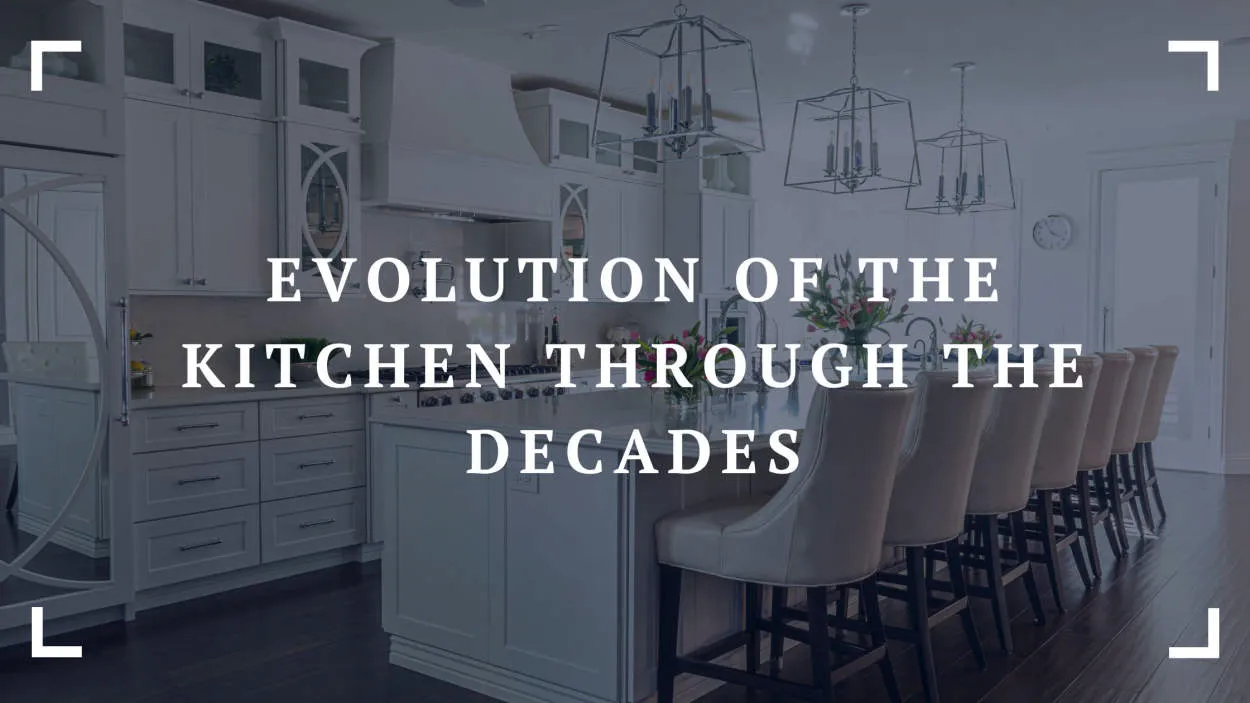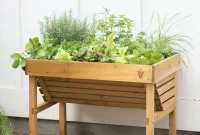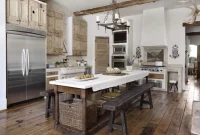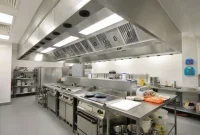The evolution of kitchen design has drastically transformed over time, presenting a rich history that reflects the changing needs and lifestyles of individuals. From traditional hearths to modern showpieces, this article explores the fascinating journey of kitchen design from the past to the present.
Historical Kitchen Styles
In the article “The Evolution of Kitchen Design: Past to Present,” we explore the development of kitchen styles from ancient times to the modern era. Throughout history, kitchens have undergone significant transformations, influenced by cultural, technological, and social changes.
Ancient Kitchens
In ancient civilizations such as Egypt, Greece, and Rome, kitchens were primarily functional spaces with a focus on practicality. Stone hearths and clay ovens were used for cooking, and food preparation relied heavily on manual labor. These kitchens were often separate from the main living areas.
Medieval and Renaissance Kitchens
During the Middle Ages and the Renaissance, kitchen designs became more sophisticated and incorporated elements of architecture. Hearth and fireplace cooking prevailed, along with the addition of brick ovens. Wealthier households had larger kitchens with separate areas for storage and food preparation.
Industrial Revolution and Victorian Era
The Industrial Revolution brought significant changes to kitchen design. Advances in technology, such as cast iron stoves and accessible plumbing, made cooking more convenient. In the Victorian era, kitchens became more organized and efficient, with separate work areas for washing, cooking, and food storage.
Modern Kitchens
The 20th century witnessed great advancements in kitchen design. The introduction of electricity revolutionized cooking appliances, leading to the rise of refrigerators, dishwashers, and electric stoves. Kitchen layouts became more open and integrated into living spaces, reflecting changes in lifestyle and social dynamics.
Contemporary Trends
Today, kitchen design revolves around functionality, aesthetics, and sustainability. Minimalist styles with clean lines and efficient storage solutions have gained popularity. The focus is on creating a space that facilitates cooking and socializing, often with features such as kitchen islands and open-plan layouts.
Modern Adaptations of Classic Designs
The evolution of kitchen design has witnessed a remarkable transformation from traditional styles to the incorporation of modern elements. Today, designers and homeowners alike are embracing the concept of merging classic and contemporary aesthetics to create stunning kitchen spaces that blend functionality with timeless charm.
One prominent trend in modern kitchen design is the use of traditional materials such as marble, brass, and natural wood in combination with sleek, minimalist finishes. This juxtaposition creates a visually striking look that pays homage to the past while embracing the clean lines and simplicity of modern design.
Another adaptation of classic designs is the integration of smart technology into kitchen appliances. From refrigerators with touchscreens to voice-activated faucets, these innovations not only add convenience to daily cooking routines but also elevate the overall aesthetic appeal of the kitchen.
The concept of open shelving has also gained popularity in modern kitchen designs, offering a contemporary twist to traditional cabinetry. By showcasing dishes, glassware, and cookbooks in an organized manner, open shelving adds a personalized touch and creates an illusion of more space, making it a perfect choice for smaller kitchens.
Finally, the revival of farmhouse sinks has become a prominent feature in modern kitchens. These deep, spacious sinks not only evoke nostalgia but also provide practicality for large families or avid home cooks. With their sleek designs and various materials available, farmhouse sinks blend seamlessly into both classic and modern kitchen settings.
In conclusion, the evolution of kitchen design has witnessed a harmonious marriage of classic and modern elements. From the use of traditional materials in contemporary finishes to the integration of smart technology and the reinvention of classic features, modern adaptations of classic designs have revitalized kitchen spaces, offering functionality, visual appeal, and a nod to the past all at once.
Technological Advancements in Kitchens
In the ever-evolving world of kitchen design, technological advancements have played a significant role in transforming the way we experience and utilize this essential space. From the humble beginnings of basic cooking tools to the modern, high-tech kitchens of today, the evolution has been nothing short of remarkable.
Smart Appliances
One notable advancement is the introduction of smart appliances. These innovative devices are equipped with features that allow for remote control and monitoring. From Wi-Fi-enabled refrigerators that can create grocery lists to self-cleaning ovens that can be preheated on the way home, these appliances are paving the way for a more convenient and efficient cooking experience.
Intuitive Cooktops
Cooktops have also witnessed significant advancements. Induction cooktops, for instance, use electromagnetic technology to heat pans directly, providing faster and more precise temperature control. Additionally, touch-sensitive controls and intuitive interfaces have made cooking more user-friendly and accessible.
Integrated Technology
The integration of technology within kitchen design has become increasingly common. From built-in speakers and high-definition screens for entertainment purposes to smartphone integration for recipe suggestions and cooking timers, kitchens have become more than just a place for culinary tasks; they have become multi-functional hubs for the entire family.
Efficient Storage Solutions
Gone are the days of cluttered cabinets and disorganized pantries. Modern kitchen design incorporates intelligent storage solutions that maximize space and accessibility. From pull-out shelves and hidden compartments to innovative organization systems, these technologies ensure a tidy and efficient kitchen environment.
Sustainable Practices
Technological advancements in kitchens are not only focused on convenience but also sustainability. Energy-efficient appliances, water-saving features, and recycling systems are becoming standard in many kitchens. From composting units to smart water meters, these advancements aim to reduce waste and minimize our ecological footprint.
In conclusion, the technological advancements in kitchens have revolutionized the way we interact with and benefit from this vital space. From smart appliances to intuitive cooktops, integrated technology to efficient storage solutions, and sustainable practices, these advancements continue to shape the future of kitchen design.
Fusion of Old and New Trends
The Evolution of Kitchen Design: Past to Present
Kitchen design has gone through a remarkable evolution over the years, blending together old and new trends to create spaces that are both functional and stylish. From humble hearths to modern smart kitchens, the transformation has been awe-inspiring.
Past: Traditional and Nostalgic Designs
In the past, kitchen designs were focused primarily on functionality rather than aesthetics. The emphasis was placed on creating efficient workspaces to facilitate cooking and meal preparation. Traditional kitchen designs often featured rustic elements, such as wooden cabinets, stone countertops, and open shelving.
Moreover, old trends like vintage appliances, farmhouse sinks, and ornate details added a nostalgic touch to the kitchen space. These traditional designs evoked a sense of charm and warmth, reminding people of simpler times.
Present: Contemporary and Innovative Designs
Today, kitchen design has shifted towards a more contemporary and innovative approach. The focus is on creating sleek, minimalistic spaces that are visually appealing while still being highly functional. Modern kitchens often feature clean lines, glossy finishes, and state-of-the-art appliances.
Furthermore, the integration of technology has revolutionized kitchen design, giving rise to smart kitchens equipped with appliances that can be controlled remotely and offer advanced features like voice-activated commands and automated cooking processes.
Fusion of Old and New: The Best of Both Worlds
As kitchen design continues to evolve, a fusion of old and new trends emerges. Designers are incorporating traditional elements into modern kitchens to create a harmonious balance between functionality and aesthetics.
For instance, farmhouse sinks and vintage lighting fixtures are being paired with sleek cabinetry and modern countertops. This blend of old and new creates a unique and timeless look that appeals to homeowners who appreciate the charm of the past while embracing the convenience offered by modern technology.
In conclusion, the evolution of kitchen design showcases the fusion of old and new trends, resulting in spaces that beautifully combine functionality, nostalgia, and innovation. Whether you prefer a traditional farmhouse kitchen or a contemporary smart kitchen, there are designs available to cater to every taste and lifestyle.
Nostalgic Decor Elements
The evolution of kitchen design has brought about significant changes in decor elements. However, amidst these modern advancements, there are still some nostalgic decor elements that continue to make a lasting impression. These elements not only add charm and character to the kitchen but also evoke a sense of nostalgia and reminisce about the past.
1. Vintage Appliances
Vintage appliances have made a comeback in modern kitchen designs. From retro refrigerators to antique stoves, these appliances showcase the elegance and retro charm of the past. The vibrant colors and unique designs of these appliances can instantly transport you back in time.
2. Patterned Tiles
Patterned tiles are another nostalgic decor element that has regained popularity in kitchen designs. Whether it’s intricate mosaic patterns or classic checkerboard designs, these tiles add a touch of old-world charm. They create a visually appealing focal point in the kitchen while paying homage to traditional craftsmanship.
3. Farmhouse Sink
The farmhouse sink, also known as an apron sink, is a timeless feature that reflects the charm and simplicity of old-fashioned kitchens. With its large basin and exposed front, it adds a rustic touch to any kitchen design. These sinks not only enhance the aesthetics but also offer practicality and durability.
4. Open Shelving
Open shelving is a throwback to the days when kitchens prominently displayed their utensils, dishes, and cookware. This design trend allows homeowners to showcase their collection of vintage crockery and cookbooks. Open shelves give a glimpse into the past while providing a practical storage solution for everyday items.
5. Butcher Block Countertops
Butcher block countertops add warmth and nostalgia to modern kitchen designs. These wooden countertops were commonly used in traditional kitchens for their durability and versatility. They provide an organic and natural feel to the space, and the natural patina that develops over time tells a story of countless meals prepared over the years.
Conclusion
In conclusion, the evolution of kitchen design from the past to the present has been remarkable. It has gone through significant changes, reflecting advancements in technology, lifestyle, and aesthetics. From the functional and practical kitchens of the past to the sleek, modern designs of today, the kitchen has become the heart of the home, combining style and functionality in innovative ways.




